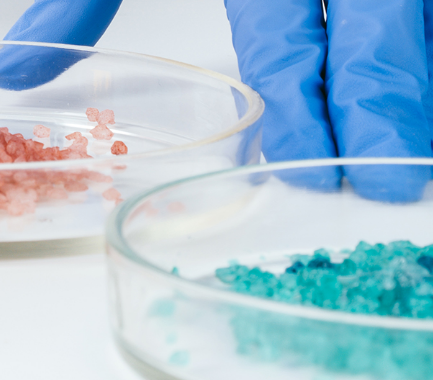Your contact
PENPET-Team - Hamburg

Tim Meister
Sales
Tel. +49 (0) 40 - 675 7 99 40
sales@penpet.de
Get in touch with us.
Maleic Anhydride (MA)
Maleic Anhydride (MA), which belongs to the group of carboxylic acid anhydrides, is an important intermediate in chemical industry processes. As an anhydride, it theoretically differs from maleic acid, which gives it its name, by the removal of a water molecule from the two carboxylic acid groups. In practice, however, maleic anhydride is produced in other ways. The gas-phase oxidation of n-butane is widespread today. Maleic anhydride and water are formed in this process at temperatures of around 400 °C and with the addition of vanadyl pyrophosphate catalysts. The previously widespread production from benzene and atmospheric oxygen has now receded into the background due to rising benzene prices and considerable carbon dioxide emissions.
Maleic Anhydride is used as an intermediate in the manufacture of numerous products in the chemical industry. In addition to unsaturated polyester resins, alkyd resins and surfactants, these also include crop protection agents and growth regulators. Also important is the copolymerization together with α-olefins, the reaction products of which are used as lubricants. Furthermore, maleic anhydride is reduced, for example, to tetrahydrofuran and 1,4-butanediol.
We hold Maleic Anhydride on stock and we can also deliver larger quantities at short notice, but we prefer regular deliveries on a monthly or quarterly basis. We look forward to receiving your inquiry for an individual offer. Delivery is in liquid form heated in ISO containers or road tankers and in solid form as briquettes and pastilles.
CAS no. 108-31-6
EINECS no. 203-571-6
Molecular formula: C4H2O3
Synonyms: MSA, MA, furan-2,5-dione, 2,5-furanedione, (Z)-butenedioic anhydride, cis-butenedioic anhydride, cis-ethylenedicarboxylic anhydride, 2,5-dioxo-dihydrotetrafuran, dihydro-2,5-dioxofuran, maleic anhydride
Application examples: Production of polyester resins, among other things for glass fiber plastic, as well as production of alkyd resins, plasticizers, surfactants, lubricants, pesticides and other chemical industry products
More Information
The structure as a carboxylic acid anhydride is characterized by the two carboxylic acid groups, which are linked by the removal of a water molecule via an oxygen atom. These are located at the ends of a symmetrical butene chain, closing it into a cyclic structure. With a relatively small molecular size, Maleic Anhydride therefore has several reactive components and contains only two hydrogen atoms due to the compact arrangement and one double bond. In contact with water, it quickly turns into maleic acid through hydrolysis.
Maleic Anhydride occurs as a solid in the form of white or colorless flakes and crystals, but due to its low melting range it is also traded and stored as a hot melt. In addition, the substance changes directly into the gaseous state at room temperature. Maleic Anhydride gives off a sharp, penetrating odor.
Maleic Anhydride is readily soluble in diethyl ether and most other organic solvents. In water, it rapidly hydrolyzes to maleic acid.
Maleic Anhydride is extremely reactive and is suitable for use as a monomer or comonomer in polymerization processes. In addition to polycondensation reactions, maleic anhydride can also be used in polyaddition reactions. As an unsaturated compound, it tends to undergo addition reactions with the breaking of its double bond. Dimerization to cyclobutanetetracarboxylic acid dianhydride, which is used in LCD screens, for example, can also take place under UV light. Two molecules of maleic anhydride each break their double bonds and instead connect via a square carbon structure.
In water, Maleic Anhydride hydrolyzes exothermically to maleic acid. In contact with alcohols, the corresponding maleic acid esters are formed. When reacting with amines or ammonia, monoamides are formed. In general, maleic anhydride reacts quickly with strong oxidizing agents, but also with bases and most metals.
Maleic Anhydride is combustible but not flammable and in its pure form not explosive. However, the formation of explosive dust-air mixtures cannot be ruled out. In this case, ignition is possible from ignition sources such as grinding sparks or electrostatic charges.
Maleic Anhydride is harmful if swallowed; organ damage and mucosal ulcers, among other things, can occur. After accidental ingestion of the compound, the mouth should be rinsed out immediately with water and plenty of water should be drunk afterwards. Direct contact with the compound can cause serious eye damage, severe skin burns and allergic skin reactions. Affected areas should be rinsed thoroughly and medical attention sought. Maleic anhydride is also corrosive to the respiratory tract. Inhalation of dusts or vapors may cause temporary breathing difficulties, allergic reactions and asthmatic symptoms. Even fatal pulmonary edema can occur. Repeated or prolonged exposure can cause permanent damage to the airways and trigger chronic bronchitis. Comprehensive protective measures must therefore be taken. Containers must not be left open.
Due to its rapid hydrolysis to maleic acid, maleic anhydride does not persist in the environment for long. However, the compound is harmful to aquatic organisms and is considered a slightly water-polluting substance. Maleic acid is biodegradable.
